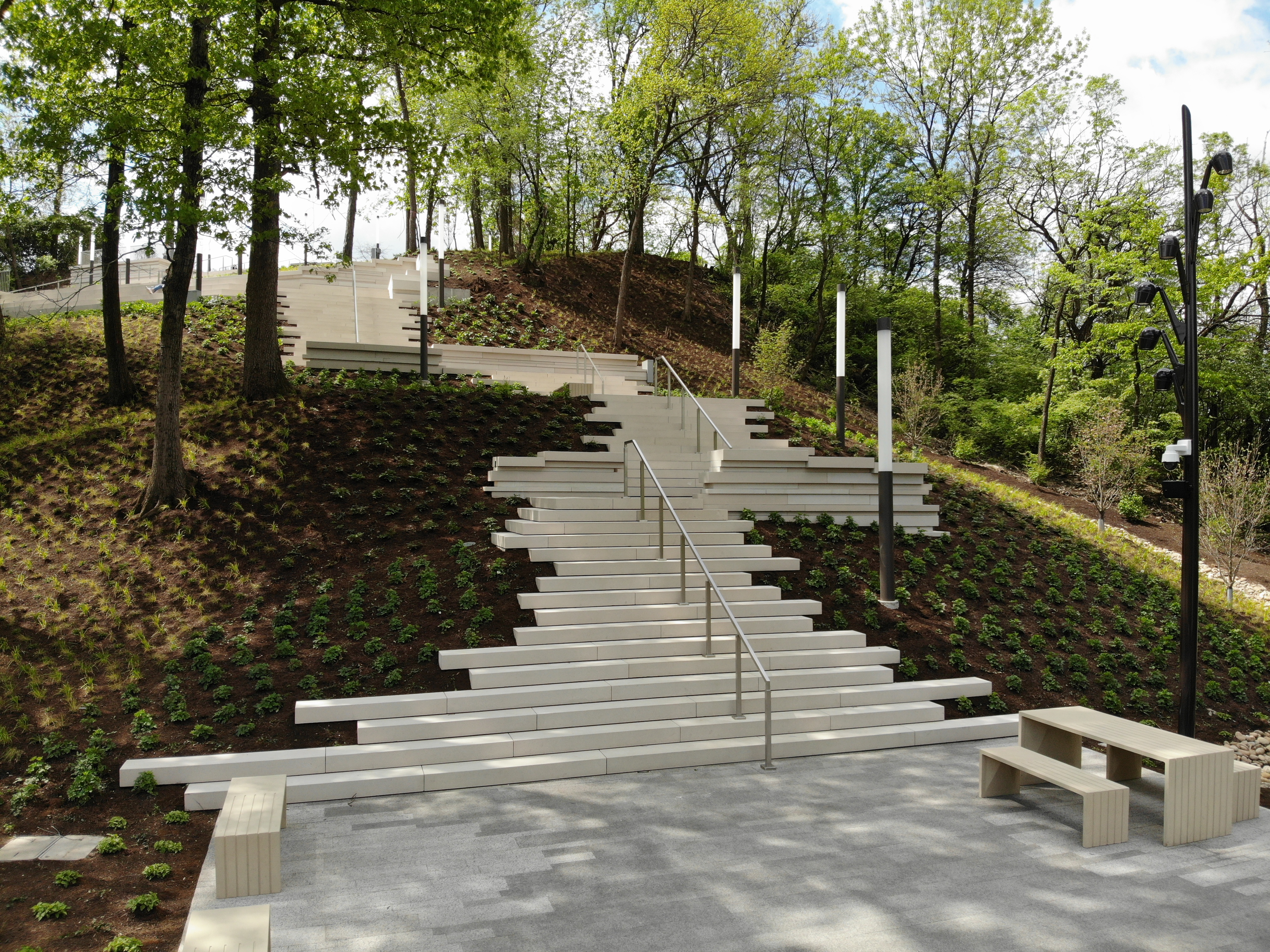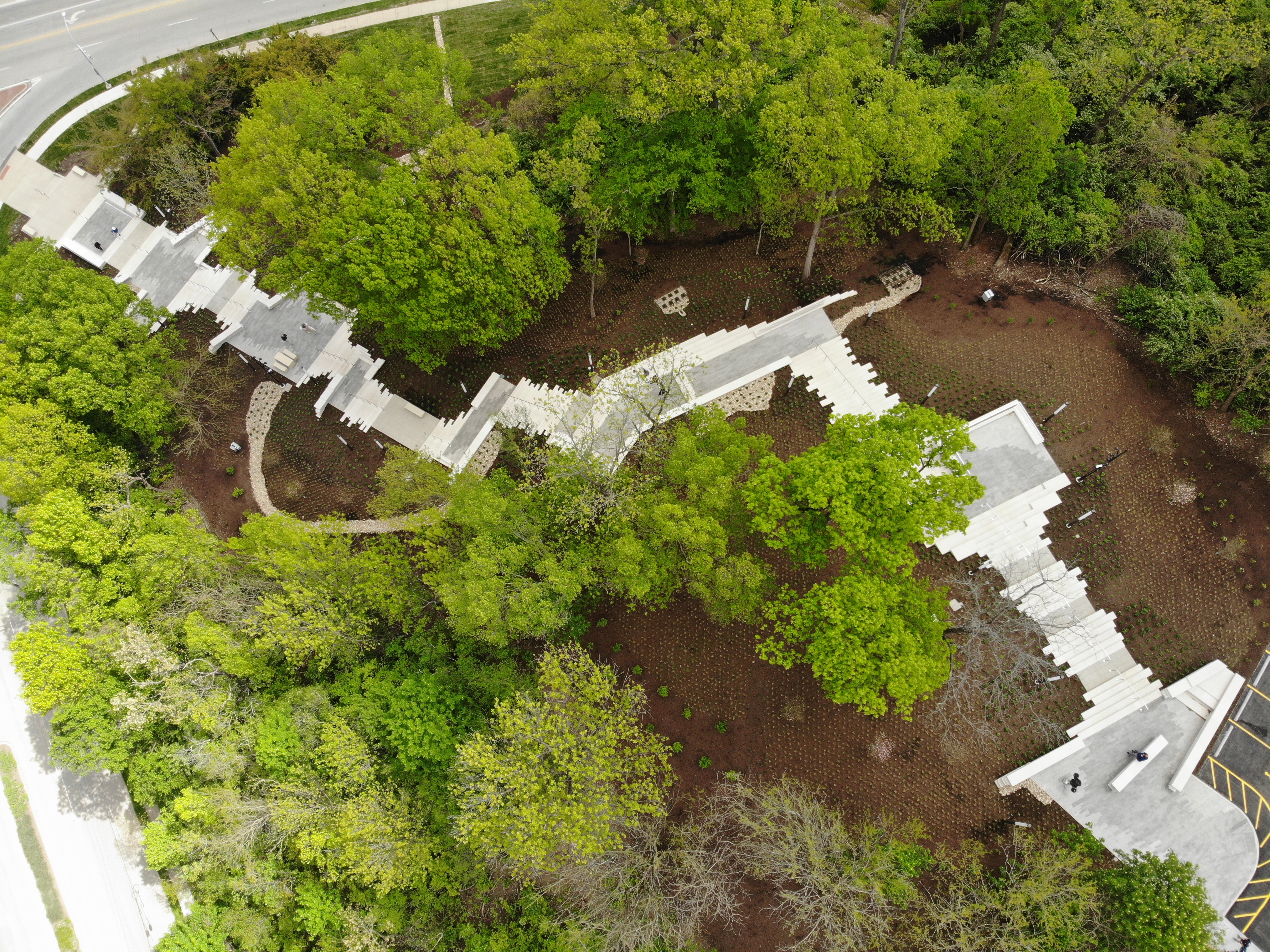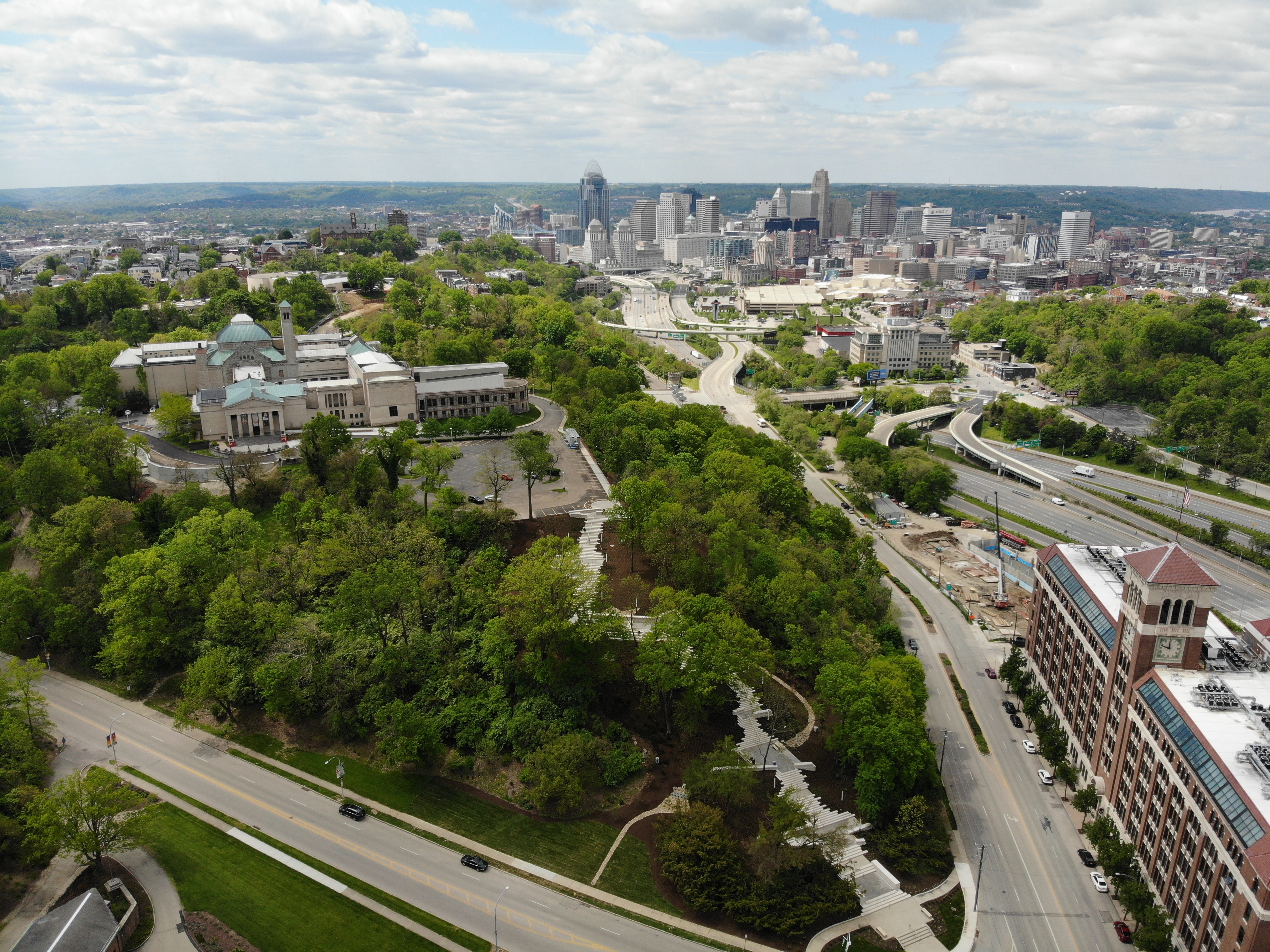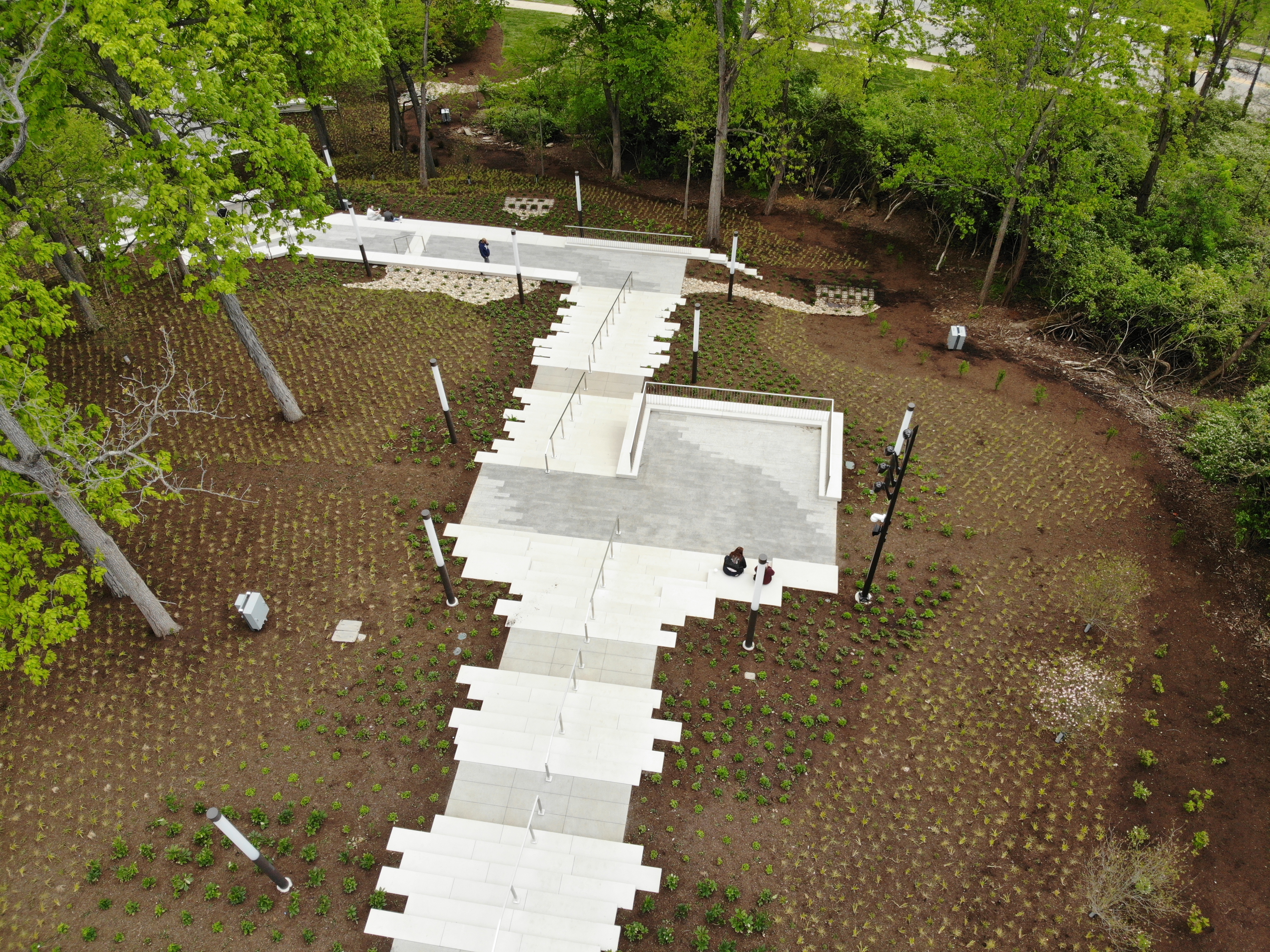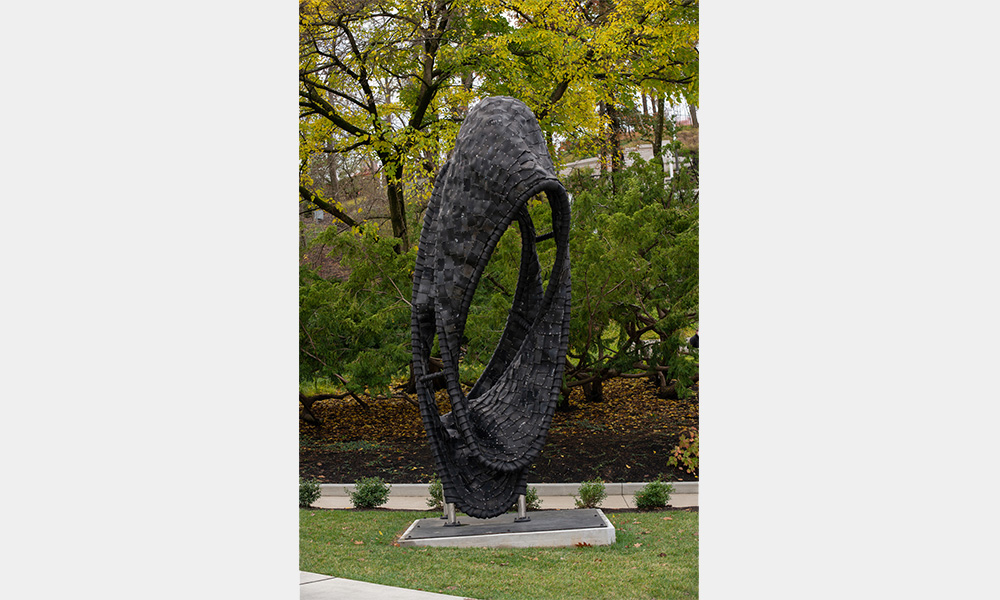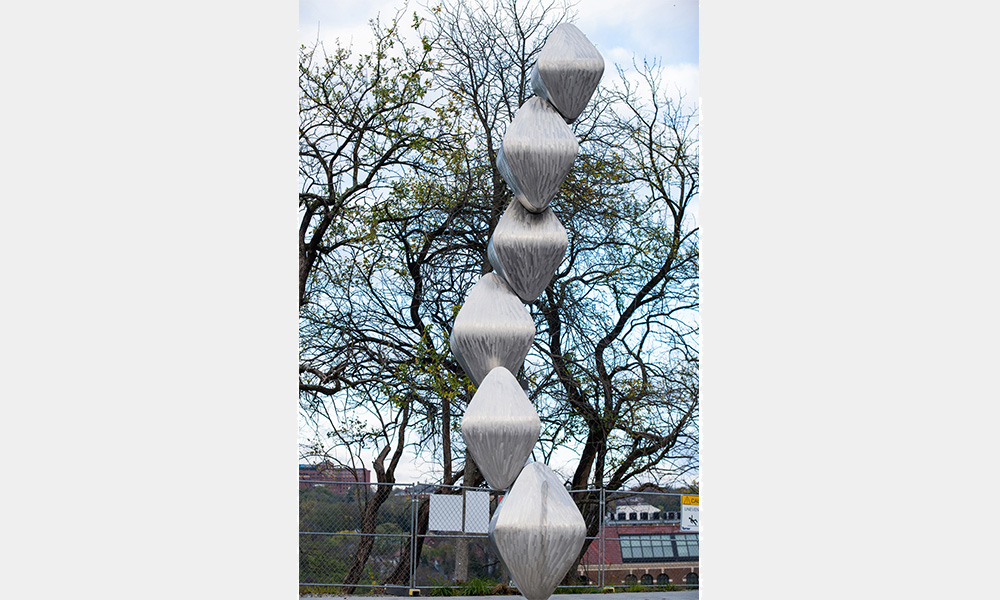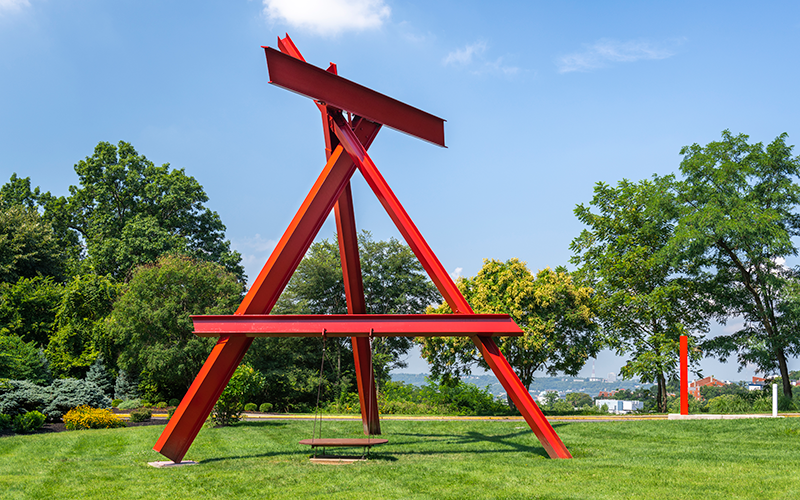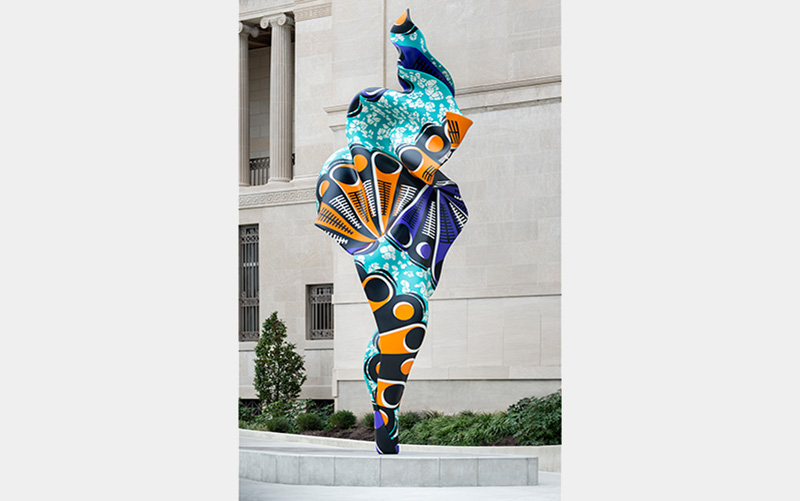Welcome to the Art Climb
It’s an art experience—not just steps.
Located at the corner of Gilbert Avenue and Eden Park Drive, the Art Climb engages with its surrounding historic, vital neighborhoods, including Walnut Hills. This activation of the museum grounds allows new and broader access through casual and recreational art interactions outside the walls of the museum. There are currently three outdoor sculptures on view including two works from the Pyramid Hill Sculpture Park & Museum’s collection.
Multiple flights of steps and landings span the hill at the northern corner of the museum’s grounds, around 450 feet from the street to the parking lot. Art Climb incorporates a lighting component that guides visitors up toward the museum. At the top of the staircase, visitors have an opportunity to access a large pavilion where they can enjoy a view of the city. A Cincinnati Metro bus stop is located near the start of the staircases.
The museum worked with Emersion Design and Human Nature for architecture and landscape design for this project. Turner Construction was the construction firm. Effort was taken to retain as many trees as possible during the construction of the Art Climb. Invasive honeysuckle and diseased ash trees have been removed.
Please use caution and handrails when ascending and descending stairs. When sharing images on social media, please include #CincyArtClimb.
Art Now on View
Art Climb Accessibility
Due to the steepness of the hillside (at nine stories), the Cincinnati Art Museum was unable to make Art Climb ADA accessible. The top landing will be made ADA compliant with the addition of a ramp.
CAM’s indoor permanent art collection and special exhibitions are fully accessible. Park in the lot nearest the building and use the new ramp into the museum, which is ADA accessible. For more information about accessibility, visit the Access page.
View our full list of FAQs here
Art Climb by the numbers
- 9 stories high
- 164 steps
- 16 landings
- 4 art plazas
- Integrated with trails, continuous paths and new arrival drive to come
What is Art Climb?
Art Climb is a one-of-a-kind outdoor civic and art space on the grounds of Cincinnati Art Museum.
How is Art Climb part of Cincinnati Art Museum?
Art Climb is the first stage in a comprehensive plan for Cincinnati Art Museum’s entire site. Connections to multiple distinctive neighborhoods were founding principles for the museum in the nineteenth century. This new artistic experience reactivates those key historic links with Mt. Adams, Walnut Hills, Mt. Auburn, Gilbert-Sinton, Pendleton and Downtown. Art Climb will be followed in future phases by trails, art spaces and a new vehicular and pedestrian approach to arrive at the museum. This project lets the museum expand in an unexpected and exciting way.
Who will “use” the Art Climb?
The Art Climb was conceived to connect the city and its museum more tangibly, and more experientially, than has been true in the past. It is a way to integrate Eden Park’s (and Cincinnati’s) distinct topography with outdoor sculptures. We expect visitors to the museum to wander its spaces and visitors to the city to identify it as one of Cincinnati’s great scenic offerings. We can imagine park-goers picnicking on its landings, athletes running its stairs, community groups meeting at its base and passers-by— sometimes—climbing it to see where it goes. We hope that it will develop a foothold on our imaginations as we think of the Cincinnati Art Museum’s outreach.
Is Art Climb in Eden Park?
Yes! All of Cincinnati Art Museum is proudly located in Eden Park. The land on which the museum and Art Climb are sited are separately managed and overseen by the museum, but firmly within the historic park. Cincinnati Parks and the Cincinnati Art Museum are close allies serving the public good.
Does Art Climb have a map?
Absolutely. See it below or download your own.
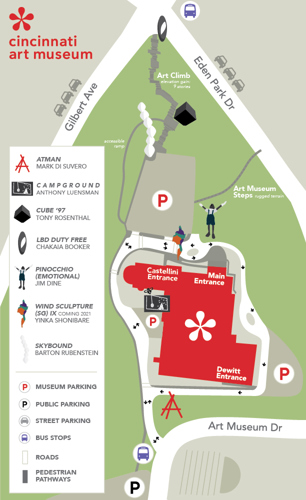
Why is the Art Climb experience valuable?
Art Climb provides a different way of taking in the power of art to unite, challenge, and share intellectual and aesthetic beauty. We have taken to calling it “recreational art interaction.” Everything we know and have learned tells us that this evolution is central to today’s visual arts: casual, kinetic, informal, interconnected, democratic, boundaryless and enjoyed on your terms. Art Climb adds a new outdoor gallery dimension to the museum.
What examples were studied when before creating Art Climb?
Seattle Art Museum’s Olympic Sculpture Park, New Orleans Museum of Art’s Besthoff Sculpture Garden, Crystal Bridges Museum of American Art’s grounds in Bentonville, Arkansas, Belgium’s Hallerbos forest, Walker Art Center’s Minneapolis Sculpture Garden, North Carolina Museum of Art Park, and more, were studied as creative examples. But Art Climb is unique. Cincinnati’s defining topography and Cincinnati Art Museum’s proximity to key neighborhoods make Art Climb an idea like no other. It is a Cincinnati experience.
How much does it cost to visit Art Climb?
Art Climb and the art experiences are free, as is general admission to the museum itself.
Where will I park?
Visitors to Art Climb can park in museum parking lots, legal street parking on Gilbert Avenue and Eden Park Drive or garage parking near SpringHill Suites on Eden Park Drive. Alternatively, Art Climb is situated on Metro bus lines #4, #11 and #1.
Who designed Art Climb?
Art Climb was conceived by an ad hoc group of Cincinnati designers, trustees, builders and museum leadership in creating the museum’s visionary 2016–2021 strategic plan. Human Nature and emersion DESIGN of Cincinnati are the lead professional concept and design teams. Art Climb was refined with numerous neighborhood councils, Parks experts in tree preservation and Cincinnati Development Fund’s visionary community development work. Brave Berlin’s creative workshops were essential. Turner Construction was the general contractor and a key partner. Art Climb has already won a 2019 Cincinnati Design Award.
Can I take photos at Art Climb?
Please do! Snap, post, like, share, TikTok—and tag Cincinnati Art Museum.
How is Art Climb funded?
Private fundraising and New Market Tax Credits generated by the project compose 100% of the funding for Art Climb. The project’s connection with the historic neighborhood of Walnut Hills is integral to its purpose and execution. Cincinnati Development Fund’s community advancement work has been instrumental to the project’s feasibility. Cincinnati Art Museum’s site master plan is estimated at $20 million in infrastructure excluding long-term art acquisition. Procter & Gamble and other community partners are among the lead investors in our plan’s resource development.
How will Art Climb change over time?
The trees and vegetation will continue to mature. Most importantly, we are excited to see Art Climb take on its own life as a civic space and a future that shapes itself by bringing people, art and nature together.
How does Art Climb connect with working artists?
As is celebrated in the museum’s galleries at 953 Eden Park Drive, Art Climb is an intersection of worldclass art of diverse cultures and artists from around the world. The story of the museum’s Cincinnati Wing and our vibrant living arts scene will undoubtedly contribute to the grounds as collections develop and installations change and advance.
Will Art Climb be lit and secured?
We have invested in a lighting scheme for Art Climb to make it a safe and monitored environment. Security cameras throughout the grounds give us eyes in the sky. By design, no fences or gates will barrier Art Climb from our neighborhood.
Who will maintain Art Climb?
Cincinnati Art Museum will maintain, own and program Art Climb. We are excited to add expert horticultural leadership to our team soon. We have gained new knowledge from our friends at Cincinnati Zoo and Pyramid Hill along the way.
Can I approach Art Climb from the top of the hill and walk down?
Since nine stories of steps can be a challenge, a water fountain awaits you at the top landing. And yes, please bring your dog for a walk. Also, we are working towards broader continuous ramp accessibility around the grounds for strollers and wheelchairs as the plan grows and the museum’s new front drive is built, we expect by 2021. We are 100% committed to serving all visitors.
Will the hillside hold?
Modern engineering technology, Strand Associates and Terracon's consulting engineers and scientists have introduced micro-piling, core drill testing and other advanced techniques to assure long-term stability. The museum’s hill does not exhibit the same Cincinnati shale condition as does Columbia Parkway; Cincinnati Art Museum is built on bedrock. The removal of invasive, shallow-rooted honeysuckle vine allows carefully protected trees identified by Parks staff and Human Nature to thrive again.
Does Art Climb fit with the history of Cincinnati Art Museum and Eden Park?
Absolutely. Museum steps from Eden Park Drive, Elsinore Gate steps on Gilbert Avenue, and Holy Cross- Immaculata steps in Mt. Adams are important parts of our City’s history. Mary Anna DuSablon’s Walking the Steps of Cincinnati identifies 34 “perpendicular public paths” across 26 Cincinnati neighborhoods. Art Climb references and revives that history.
The 1925 City of Cincinnati Plan notably and lyrically suggests: “As to the detailed treatment of the steeper hillsides, the policy now pursued by the Board of Park Commissioners on the steep slopes of Eden Park along Gilbert Avenue is probably as practical as any. This policy consists in holding the sliding slopes by vines, shrubs and small trees which have been proved to have particularly strong and quick growing roots which hold the soil. Threading these hillsides with narrow paths and promenades bordered by seats, shelters or pergolas, renders them useful and attractive and gives variety to the pictures as seen from below.
It is even suggested that new types of play could be developed that would be especially adaptable to these hillsides, whether by featuring games, like bowls, archery and the like, which demand long narrow spaces that might be laid out on narrow terraces, or whether by the invention of new games that could be played effectively on the natural slope.”
There's a lot of great momentum near Art Climb, what's happening?
Cincinnati Art Museum welcomes Cincinnati Ballet to the Gilbert Avenue/Eden Park corridor. The Ballet is a longstanding and vital partner with the museum. Our collaborations will continue to grow and expand with the Ballet’s exciting new location. The developing avenue of arts organizations, including Playhouse in the Park, Krohn Conservatory and Seasongood Pavilion in Eden Park and the coming CROWN bicycle and walking trail, will form continuous connectivity to Mt. Adams, Walnut Hills, Gilbert-Sinton, Pendleton, Mt. Auburn, Downtown and beyond. While the Ballet’s main productions are in venues downtown, the Ballet’s Academy, staff, company, training and physical therapy will populate our neighborhood every day.
Renderings provided by Human Nature.
Explore more outside!
From adding a horticulturist to our staff, to opening the transformative Art Climb, to our most recent undertaking of bringing visitors to the museum up a new front drive, we aim to embrace art and community more than ever outside the museum walls. In these times, and into the future, enriching our presentation of sculpture in outdoor settings is a crucial part of this activity—through loans, restaging our collection, and new acquisitions.


